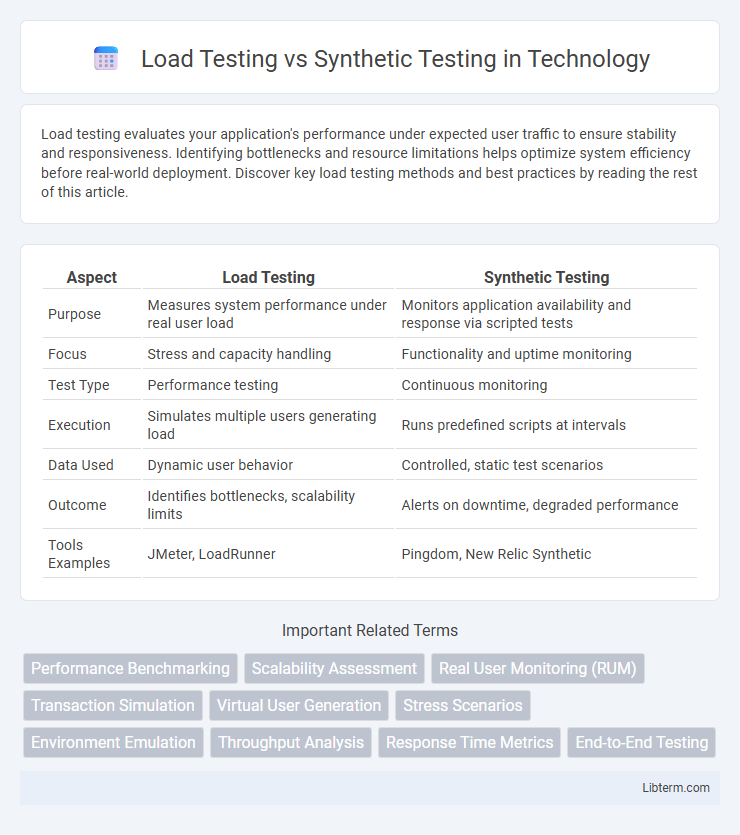Load testing evaluates your application's performance under expected user traffic to ensure stability and responsiveness. Identifying bottlenecks and resource limitations helps optimize system efficiency before real-world deployment. Discover key load testing methods and best practices by reading the rest of this article.
Table of Comparison
| Aspect | Load Testing | Synthetic Testing |
|---|---|---|
| Purpose | Measures system performance under real user load | Monitors application availability and response via scripted tests |
| Focus | Stress and capacity handling | Functionality and uptime monitoring |
| Test Type | Performance testing | Continuous monitoring |
| Execution | Simulates multiple users generating load | Runs predefined scripts at intervals |
| Data Used | Dynamic user behavior | Controlled, static test scenarios |
| Outcome | Identifies bottlenecks, scalability limits | Alerts on downtime, degraded performance |
| Tools Examples | JMeter, LoadRunner | Pingdom, New Relic Synthetic |
Introduction to Load Testing and Synthetic Testing
Load testing evaluates an application's performance by simulating multiple users accessing the system simultaneously to identify bottlenecks and ensure stability under heavy traffic conditions. Synthetic testing uses scripted, automated transactions to monitor application functionality and availability continuously, simulating user interactions without relying on real users. Together, these testing methods provide comprehensive insights into both performance limits and ongoing operational health of software systems.
Defining Load Testing
Load testing evaluates an application's performance by simulating real-world user traffic to measure system behavior under expected peak loads. It identifies bottlenecks, responsiveness, and scalability issues by applying increasing demand until the system's threshold is reached. Key metrics in load testing include response time, throughput, error rates, and resource utilization, which help ensure the application can handle production-level traffic reliably.
What is Synthetic Testing?
Synthetic testing involves simulating user interactions and transactions on a website or application to proactively monitor performance and availability. It uses scripted, automated tests executed at regular intervals from multiple locations to detect issues before real users are affected. This method helps identify bottlenecks, downtime, and functional errors, offering continuous insights into user experience and system health.
Key Differences Between Load Testing and Synthetic Testing
Load Testing measures system performance under real or simulated peak user traffic to identify bottlenecks and ensure scalability, while Synthetic Testing uses scripted, automated transactions to continuously monitor application availability and functionality from multiple locations. Load Testing emphasizes stress levels and capacity limits, focusing on response times and throughput during heavy usage, whereas Synthetic Testing centers on early detection of performance issues by simulating user interactions regardless of actual user load. Load Testing is generally executed during pre-production or controlled environments, and Synthetic Testing operates continuously in production environments for proactive monitoring and alerting.
How Load Testing Works in Real-World Scenarios
Load testing simulates real-world user traffic by generating concurrent virtual users to evaluate system performance under peak conditions. It measures response time, throughput, and resource utilization to identify bottlenecks and ensure scalability. Tools like Apache JMeter and LoadRunner execute these tests to replicate diverse user behaviors and workloads in web applications and APIs.
Practical Use Cases for Synthetic Testing
Synthetic testing simulates user interactions on applications and websites to proactively identify performance bottlenecks and uptime issues before real users are affected. It is essential for monitoring critical business transactions, validating SLAs, and ensuring consistent user experience across different geographies and devices. Practical use cases include continuous uptime monitoring, API endpoint validation, and regression testing in DevOps pipelines.
Benefits and Limitations of Load Testing
Load testing measures a system's performance under expected real-world user loads, identifying bottlenecks and ensuring stability during peak usage, which is critical for capacity planning. Its benefits include revealing throughput thresholds, response times, and resource utilization under stress, helping prevent downtime and optimize infrastructure costs. Limitations involve the complexity of accurately simulating diverse user behaviors and environments, requiring significant setup time and sometimes missing rare edge cases due to predictable patterns.
Advantages and Challenges of Synthetic Testing
Synthetic testing offers the advantage of consistent, controlled simulation of user interactions to proactively identify performance bottlenecks before real users are affected. It enables continuous monitoring from multiple locations, ensuring uptime and responsiveness under varied conditions. Challenges include the inability to fully replicate complex user behavior and potential overestimation of performance due to predictable test scripts.
Choosing the Right Testing Method for Your Needs
Load testing simulates real user traffic to evaluate system performance under expected peak conditions, ideal for identifying bottlenecks and ensuring scalability. Synthetic testing uses scripted transactions to monitor application availability and response times continuously, making it effective for proactive issue detection and SLA compliance. Selecting the right method depends on your goals: use load testing for performance validation under stress and synthetic testing for ongoing health monitoring and quick issue identification.
Conclusion: Load Testing vs Synthetic Testing
Load testing measures system performance under real user traffic to identify bottlenecks and ensure scalability, while synthetic testing uses scripted transactions to monitor uptime and functionality continuously. Load testing provides insights into how applications handle peak loads, whereas synthetic testing offers proactive detection of issues before users are impacted. Combining load testing and synthetic monitoring delivers comprehensive performance analysis for robust system reliability and user experience.
Load Testing Infographic

 libterm.com
libterm.com